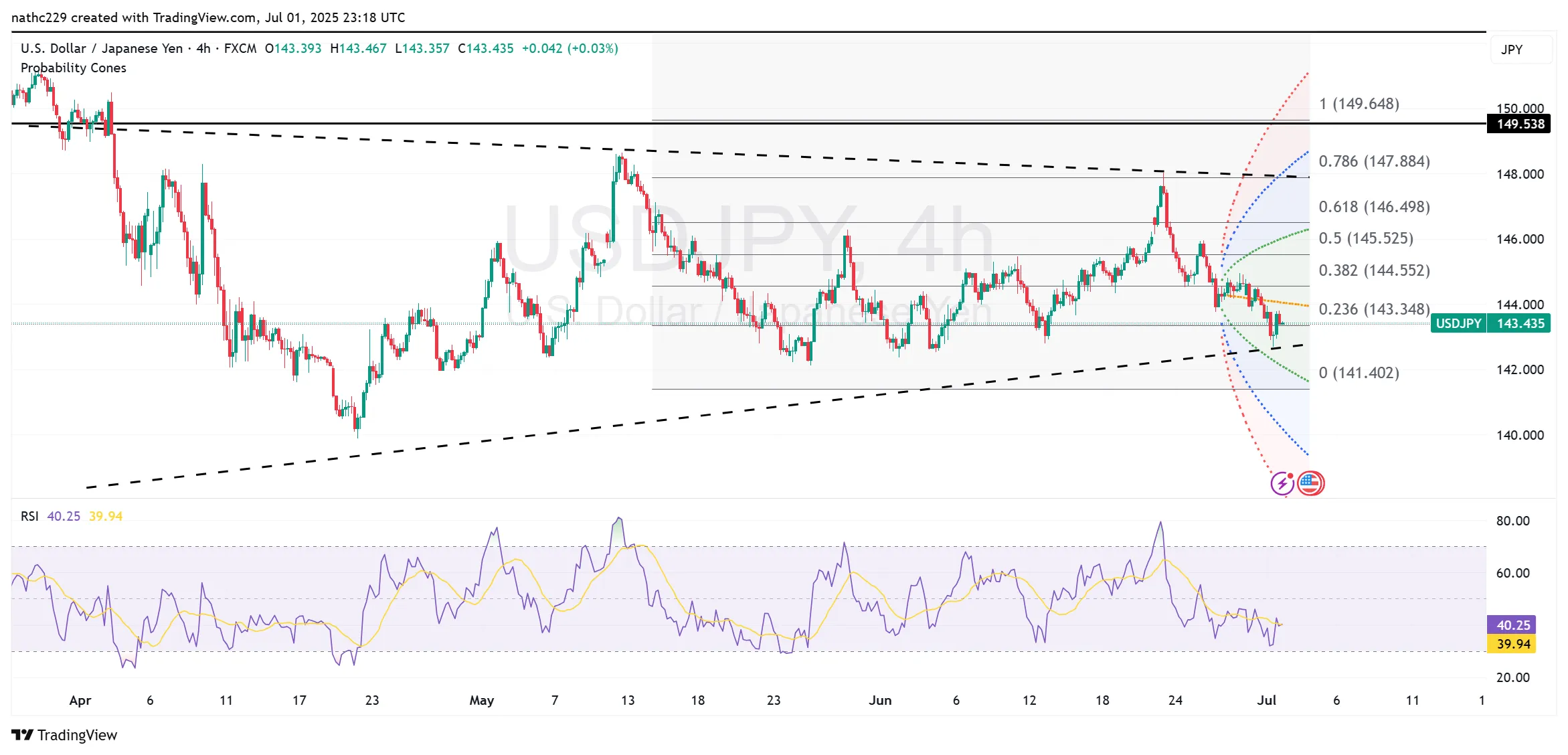
USD/JPY Vulnerable Amid Yield Pressures, Monetary Policy Outlook, and Seasonal Factors
USD/JPY Vulnerable Amid Yield Pressures, Monetary Policy Outlook, and Seasonal Factors
Overview
USD/JPY faces significant downward pressures as market dynamics surrounding monetary policy divergence, risk sentiment, and seasonal factors increasingly favor yen strength. Amid growing expectations of Federal Reserve rate cuts and potential trade tensions, the currency pair remains vulnerable, with technical indicators further underscoring bearish sentiment.
Technical Analysis
USD/JPY recently recovered marginally from early-June lows but continues to struggle under persistent bearish pressures. The currency pair remains below critical moving averages, notably the 21-day and 55-day moving averages, currently at 144.56 and 144.20, respectively. This technical positioning strongly suggests sustained bearish momentum.
Immediate support levels include the June 30 low at 142.40, the May 27 low at 142.11, and the lower support marked by the April 29 low at 141.97. A decisive break below the psychological 142.00 level could accelerate bearish momentum significantly, potentially targeting the key psychological support at 140.00.
On the upside, initial resistance is encountered at the 55-day moving average at 144.20, closely followed by the Ichimoku cloud bottom at 144.35 and the 21-day moving average at 144.56. A sustained recovery above these levels would be necessary to signal any meaningful short-term stabilization or reversal of the current bearish trend.
Momentum indicators, including the Relative Strength Index (RSI), continue to trend downward, reinforcing the bearish outlook. Traders should monitor these technical levels closely for potential breakout signals, particularly around critical support and resistance zones.
Monetary Policy Dynamics
Growing expectations for a Federal Reserve rate cut as early as September underpin bearish sentiment towards USD/JPY. Despite recent strong U.S. data, including ISM and JOLTS reports, speculation remains high regarding potential Fed rate cuts due to softer economic conditions, especially if forthcoming jobs data disappoints.
Federal Reserve Chair Jerome Powell maintains a data-dependent approach, keeping all policy meetings open for potential rate adjustments. Additionally, market speculation regarding potential leadership changes at the Fed in 2026 adds another layer of uncertainty, suggesting prolonged dovish bias could persist and weigh heavily on the dollar.
In contrast, the Bank of Japan (BOJ) remains cautious but could signal a shift towards tightening if domestic economic conditions improve post the Upper House elections and the BOJ policy meeting in late July. BOJ Governor Kazuo Ueda’s recent comments highlighted inflation nearing the bank’s target, raising the possibility of reduced monetary accommodation in the medium term, which would further support yen strength.
Risk Sentiment and Seasonal Factors
Risk sentiment remains critical for USD/JPY movements, particularly given the heightened uncertainty surrounding U.S. trade policies. Potential implementation of reciprocal tariffs on July 9 in response to President Trump’s dissatisfaction with trade talks could lead to increased risk-off sentiment, benefiting safe-haven currencies like the yen.
Seasonal patterns further bolster the yen’s outlook. July historically favors yen strength amid heightened market volatility, supporting defensive positioning in USD/JPY. Traders typically reduce risk exposure during this period, which historically strengthens demand for safe-haven assets such as the yen.
Market Positioning and Volatility
Futures open interest data indicates modest yen positioning, suggesting ample room for increased yen buying should market sentiment turn decisively bearish for the dollar. This positioning, combined with supportive seasonal factors, enhances the yen’s upside potential in the near term.
Volatility indicators in the options market currently reflect a smooth and gradual expected decline for USD/JPY. However, volatility could rise sharply if critical technical supports around the 142.00 and 140.00 levels are breached convincingly, signaling increased investor caution and hedging demand.
Risks and Strategic Considerations
Traders must remain cautious given the mixed and volatile market environment. The potential for stronger-than-anticipated U.S. economic data, such as payroll figures or successful legislative progress on fiscal stimulus measures, could temporarily reverse current bearish sentiment.
Strategically, traders with bearish positions should maintain protective stop-loss orders above critical resistance levels at 144.56 and 144.35. Conversely, bullish traders should await clear evidence of stabilization above these resistance points before considering new long positions.
Conclusion
USD/JPY remains under pronounced bearish pressure driven by monetary policy divergence, risk-off sentiment, and favorable seasonal trends for yen strength. Traders should carefully monitor economic data releases, central bank communications, and technical indicators to manage risk effectively and capitalize on potential trading opportunities.
